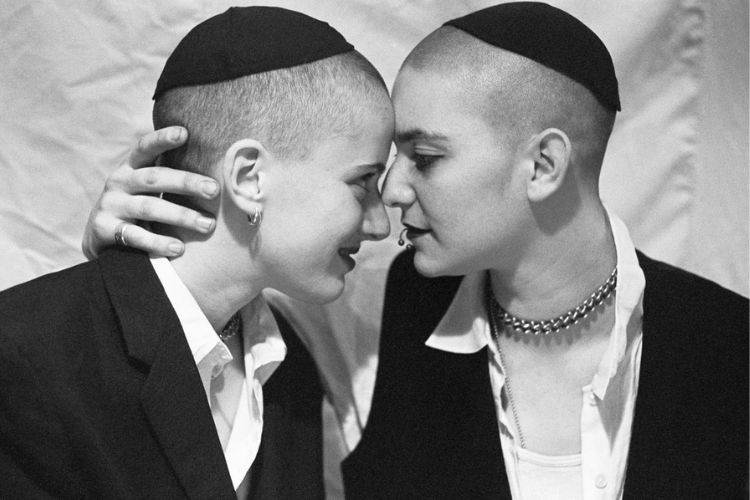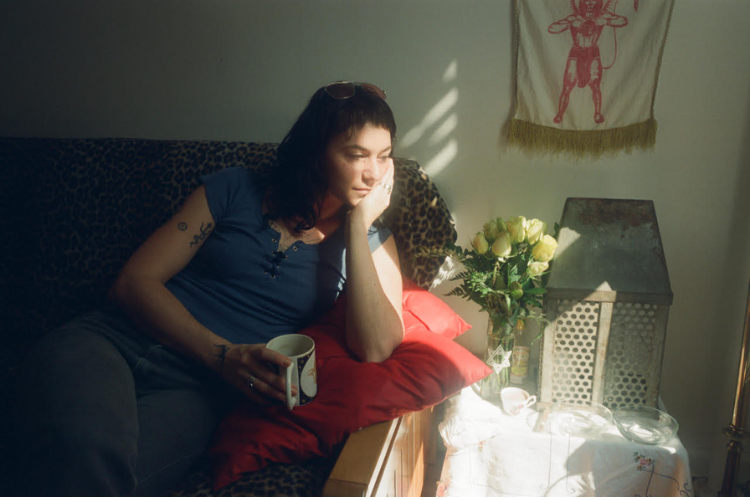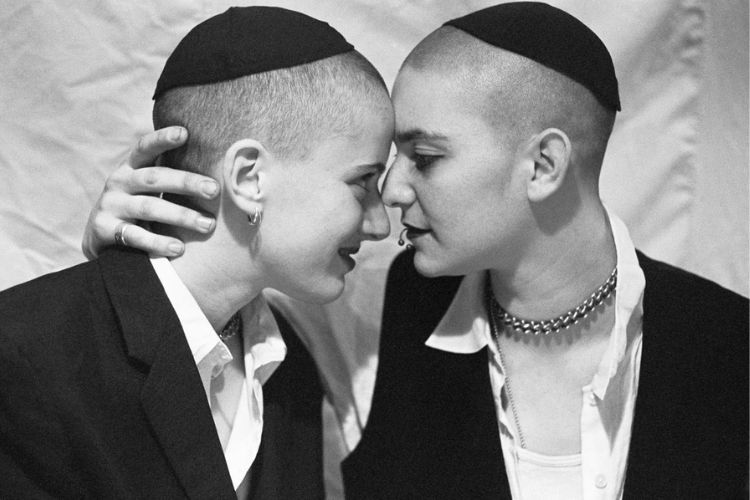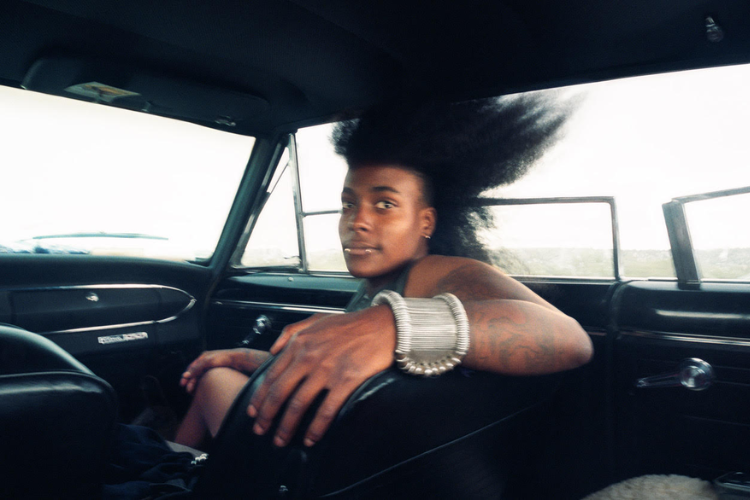
“Kindred Spirits, 1994” by Chloe Sherman
The Woman Behind The Iconic Jewish Lesbian Photograph
When I first discovered Chloe Sherman’s iconic photograph “Kindred Spirits,” I was moved by the tenderness and intimacy she was able to capture in a single snapshot — intimacy between two women, two Jewish women.
“Kindred Spirits” is just one of the incredible images in Sherman’s debut monograph Renegades: San Francisco: The 1990s. Sherman’s series intimately explores gender, sexuality, butch/femme culture, and queer community during a pivotal time in LGBTQ+ history. For Lilith, Sherman and I talked about the intersections of being Jewish, queer, and an artist and she shared the stories behind some of these evocative photographs.
Alexa Hulse: Let’s start by talking about Renegades. What inspired you to take these photos in the 90s? Why are you revisiting them now?
Chloe Sherman: I moved to San Francisco in 1991 and fell in love with the city. The vibrance and creativity of the community really was my inspiration. There was so much going on at the time. A club, event, a show, or place to go most nights of the week. This body of work largely encompasses my community, my friends, my family, my environment, and my daily life. I always had my camera with me, and I photographed copiously. My intention was always to show the world an inside view — to expose the resilience, tenderness, and joy that I witnessed and experienced in this burgeoning scene.
Today this work is not just my art, but exposes an important slice of queer history. The 90s were a time before gay marriage was legal, before LGBTQ+ representation in Hollywood and politics. There was a need for communal support in a big way. In retrospect, it is clear we were at a crux, at a turning point with LGBTQ+ acceptance and rights. Reviewing all of these photos has just reiterated what a pivotal, groundbreaking time it was in the city during this unique time of unapologetic celebration of difference and homecoming.
It is important to have documentation of our past, of our struggles and accomplishments. It is valuable for new generations to get to reflect on, and learn from their forefathers and foremothers. It is important to see how far we have come.
AH: Many of the photographs in the series center around butch and femme identities. What do you feel has stayed the same about butch/femme culture and what has changed over the past three decades?
CS: There was a strong butch/femme culture during the 90s in SF which iconically represents the time period and scene. People were confidently and publicly figuring out where they felt most comfortable with their gender. Gender identity was at the forefront of fashion, of dating, of personal expression. I feel that embracing masculinity (butch) and ultra femininity (femme) was a radical shift in queer and feminist politics away from those of the 70s and 80s that rejected traditional and ‘straight’ constructs.
Over the decades, many of the butches in my photographs have since transitioned from their assigned birth gender. However that option was not easily accessible in the early and mid 90s. I think that gender nonconformity and gender expression has a language today that was not available decades ago. Today there is awareness that people may identify as non-binary or may choose their preferred pronouns.

“Tai with Morning Light, 1996”
AH: Can you tell me a bit about your Jewish background/identity? Do you see any intersections/overlaps between your identities as a Jewish person, a queer person, and an artist?
CS: I was raised Reform Jewish and have strong cultural connections to Judaism, less so any religious attachment. I would say that what I am today is a direct result of my upbringing in an accepting, progressive Jewish family who instilled a strong sense of tikkun olam (repairing the world.) I was lucky enough to be shown by example the value and importance of giving back to the community, and of caring about others less fortunate.
With my photography, I have always felt a commitment to capturing the resilience, tenderness, and joy that I see in people in subcultures or marginalized groups. I feel that my work from the 90s SF is very much an intersection of my Jewish heritage, my queer identity, and my art. My values, my identity, my art are all revealed in this work.

“Kindred Spirits, 1994”
AH: Your photo, “Kindred Spirits,” is an iconic Jewish lesbian image. Can you share some insights about taking this photograph?
CS: Only recently have I begun to hear and realize the extent of how this image has inspired people, I am both moved and honored. This photo was taken at a Passover Seder at the Bearded Lady Cafe. My dear friends, Tai and Alessandra (the two in the photo), had been working on a side project/short film called “Bad Jews in My Kitchen” and the photo was used first as the cover/promotion for their film.
Since then, it has been published internationally, circulated in articles, on Instagram, announcements, as paintings, and even as a tattoo. Recently Tai and Alessandra met and tried to casually reenact the photo. We mostly laughed at the blurry iPhone attempt, but it would be a fun thing to try some day! I hope this image continues to remain a powerful positive influence and source of inspiration.

“Ace and Anna Joy, Cancer Sign Birthday Party, 1997”
AH: Can you tell me the story behind “Ace and Anna Joy, Cancer Sign Birthday Party”? This one is totally out of my own curiosity—it is my favorite photo of yours!
CS: Interestingly there was a large group of both Gemini & Cancer (June & July) sign birthdays. I remember often having big joint celebrations during these months. This photo is taken at Puerto Alegre restaurant on Valencia St. We often met here for dinners & celebrations. We took over a big table and booths all around. In this image, my dear friend Anna Joy is giving a birthday kiss and flowers to Ace. It’s really quite an ordinary moment, but I find that I like to capture intimate ordinary moments. Those are the endearing, intriguing stories to me.
It’s really quite an ordinary moment, but I find that I like to capture intimate ordinary moments. Those are the endearing, intriguing stories to me.
AH: What is your favorite photo in Renegades?
CS: Oh, good question! If I had to choose, I might pick the image “Elitreo in the Desert.” I find this to be a poetic and peaceful photo. Elitreo is a stunning backlit figure and the motion of their hair almost climbing out the window into the bright sky is an interesting juxtaposition to the quiet interior space. The 1960s car interior adds a timeless element. The photo is color film, but is uncharacteristic of my usually saturated color photographs.

“Elitreo in the Desert, 1998”
AH: What advice do you have to offer young queer artists?
CS: My book is titled RENEGADES: San Francisco: the 1990s to reflect the revolutionary attitudes and actions of the people in the photos, and of a community that was forging their own way off the beaten path. In the same vein, I would always encourage young queer artists to find outlets that allow for finding their way and to remain strong in their convictions. Art is self expression, is social commentary, is personal. If you are creatively inspired by other people, try to seek out community. Stick together and support each other, raise each other up to feel brilliant, intelligent, gorgeous, talented, and treasured. Find what you love, what you feel passionate about, what you believe in, and trust that it is worthy of pursuing.
If you are creatively inspired by other people, try to seek out community. Stick together and support each other, raise each other up to feel brilliant, intelligent, gorgeous, talented, and treasured.
AH: What has been bringing you pleasure and joy recently?
CS: I am currently finding great pleasure watching a baby bird in its nest directly outside our kitchen window! Spring and summer are my favorite seasons, as it brings new life, greenery, flowers, sun, long days, warmth, and to me these things feel hopeful and inspiring. Socially connecting with friends, artistically shooting to stay engaged, and traveling to stay inspired and aware.
Alexa Hulse (she/they) is a rising senior at Hollins University. She is pursuing a degree in Gender and Women’s Studies and enjoys iced matcha lattes and the moon. Alexa is Lilith’s current social media and archival intern. You can find her in “Salt and Honey”, an anthology from jGirls+ Magazine, and on Instagram @alexabhulse and @t00.soft.



